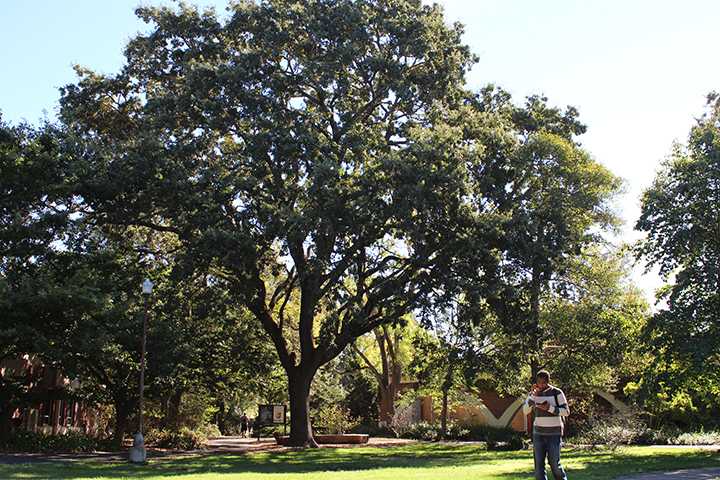Take a casual stroll around campus and one thing becomes abundantly clear: Santa Rosa Junior College is saturated with trees.
So if there were some hypothetical way for us to benefit from having so many trees, shouldn’t we indulge ourselves in its perks? Well, the hypotheticals can make like a tree and leave because now there is.
Through the Tree Campus USA program, SRJC has the opportunity to become a tree-accredited campus. This means SRJC would officially receive recognition materials demonstrating dedication to the campus’s environment. “Which is always a good thing,” said SRJC groundskeeper Carl Dobson.
Dobson heads the vast growth of oak groves scattered all over the campus, even creating a database dedicated to inventory.
“I didn’t really know about [the Tree Campus USA program],” Dobson said. But as soon as it became apparent SRJC could so easily make itself certified, Dobson was on board, spearheading the movement.
“Especially since Luther Burbank planted our campus’s first oak tree,” Dobson said.
Implementing the program mainly acts as a positive public relations effort, showing that SRJC reveres its trees as well as their maintenance.
“I had no idea such a thing even existed,” said SRJC student Matthew Cordell. “Now that I do though, I definitely hope that we meet with the standards. We have so many trees.”
By completing a simple five standard process that promotes healthy trees and student involvement, any school has the opportunity for certification.
The first standard consists of creating a campus tree advisory committee, comprised of a student representative, a faculty representative, a facilities representative and a community member, such as a city forester, municipal arborist or a community tree board member.
Standard two requires the group to meet regularly to implement a campus tree care plan. Experts suggest campuses raise approximately $3 per student to sustain the program. The plan must include a clearly stated purpose goal annually. This includes, but is not limited to:
•Putting together an authority or a department that specifically enforces the campus tree care plan.
•Establishing the campus tree advisory committee in terms of representatives and committee role.
•Creating tree care policies for planting, landscaping, maintenance and removal, which includes establishing and updating a list of recommended and prohibited species.
•Protection and preservation policies and procedures, meaning that a proper process for implementing tree protection with a step-by-step process project must follow. This includes construction and trenching.
•Developing of one goal or target, which includes but is not limited to the development of a link between the campus tree plan and other green initiatives or a completion of a campus-wide tree inventory.
•Assessing of damaged trees, including enforcements, damages and appeals.
•Prohibiting practices, such as those that discourage or work against the campus tree care plan.
•Defining of terminology or those related to campus trees.
•Implementing a communication strategy, which heightens awareness about policies and procedures as well as the goals of the institution between the campus tree care plan and the college community.
The third standard requires the tree campus advisory committee to allocate funds annually for the program.
This money would go towards the cost of trees such as labor and equipment for tree maintenance, tree care contractors, public education for students who take an interest in nature and biological endeavors and professional training for those who are interested in making a career out of nature and nature activities.
Standard four requires an arbor day observance, an annual event to educate the public on the benefits of trees.
Finally, standard five requires the tree campus advisory committee create a service learning project, which is basically an outreach that provides the opportunity to engage the student population with projects related to trees and can be part of a campus or community initiative.
After these five standards are met, SRJC has until Dec. 31 to submit an application that will be reviewed and either accepted or denied in terms of a recognized Tree Campus USA for that given calendar year.
“The phonology project is one way to get involved in the educational aspects, but it’s just that currently no student wants to head [the tree campus advisory committee] up,” said SRJC student and naturalist club treasurer Cricket Swanson.
Steadily, SRJC is on its way towards becoming an official tree certified campus. All it needs now to quicken the process is more student involvement.
In time, hopefully the community will see that photosynthesis is just a part of the daily root-ine.




